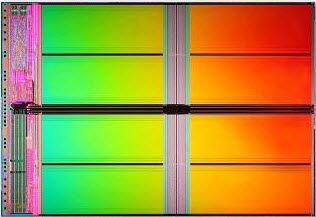Solid State Drive Buyer's Guide
Should you consider upgrading to a solid state drive? Weigh all the pros and cons and evaluate the cost and value of doing so by reading this guide.
SLC vs. MLC
Now we have to take one more technical step and take you right into the heart of what makes SSDs tick. (OK, they don’t tick per se. With no moving parts, SSDs are actually completely silent—another advantage over hard drives.) We said previously that SSDs use NAND flash chips. Within each of these chips are millions of cells. There are only two types of NAND cells today: single-layer (SLC) or multi-layer (MLC).
An SLC cell can hold one data bit, yielding a value of either 0 or 1. An MLC cell can hold more than one, with today’s technologies generally yielding two bits per cell, yielding values of 00, 01, 10, or 11. Because you can fit four times as many possible values in a cell, the data density in MLC chips is higher. This is why MLC drives inevitably have higher capacities than their SLC cousins.

There are some downsides with MLC, though. The more values you have to read from, the harder it can be to get a positive fix on a value. Consider a glass of water. If you have only two possible values, empty or full, there’s no ambiguity about the state of the glass’s contents. But if you have four possible water levels, you might need to look a little harder to see if the glass is three-quarters full or only half-full (or half-empty, depending on your disposition). MLC technology will increase the rate of erroneous value readings, which is why MLC drive controllers use more powerful error correction algorithms. Going through error correction cleans up the mistakes, but it also takes more time to guarantee accuracy. This is one reason why MLC drives generally feature slower throughput than SLC.
Beyond error correction, there are different ways to build NAND memory dies that can affect performance. For example, every memory device uses a fixed-size chunk of memory called a page to transfer data to and from an external device. The size of the page can vary from one NAND product to the next, but whereas SLC allows you to program four or more parts of a page independently, MLC requires you to program the entire page before moving to the next page. SLC is using each page more effectively, so overall performance is improved. SLC is also far more efficient at writing. An MLC array will take almost twice as long to start write programming compared to SLC.

Sign up to get the BEST of Tom's Guide direct to your inbox.
Here at Tom’s Guide our expert editors are committed to bringing you the best news, reviews and guides to help you stay informed and ahead of the curve!
Current page: SLC vs. MLC - NAND Flash Memory Performance - Tom’s Guide
Prev Page SSD Pros and Cons - Read, Write Speed vs. HDD - Tom’s Guide Next Page SSD Endurance - SLC Has 10x the Lifespan of MLC - Tom’s GuideWilliam Van Winkle is a freelance editor and tech journalist who has been writing for more than 20 years. His work has appeared on Tom's Guide, Tom's Hardware, Tom's IT Pro, AMD, Seagate, Computer Shopper, and more. He is also an author, writing poetry, short stories, and science fiction and fantasy books.
-
Shadow703793 Imo, I'd keep away with any SSD drive using a JMicron. Dosen't matter if the stutering,etc issues were fixed. Indylinx and Intel controllers are the best right now.Reply
Anyways, I got an X25-M G2 (OEM) for $220 @Newegg during Black Friday. -
grimjester The point about getting a small SSD for software and a larger disk for data can't be stressed enough. The price per GB looks completely different if you only need 64G. There's little difference in price between the cheapest hard drive you can get and the cheapest 500G one.Reply
An SSD is just an extra cost of $150-300. It has no practical effect on the storage space your computer has. -
Eggrenade I wouldn't say it's better than Anandtech's; there's no mention of random reads or writes, which is why performance just after startup is so good. It's also a lot less technical, which is probably better for most Tom's Guide readers.Reply -
Tomsguiderachel EggrenadeI wouldn't say it's better than Anandtech's; there's no mention of random reads or writes, which is why performance just after startup is so good. It's also a lot less technical, which is probably better for most Tom's Guide readers.Exactly :)Reply -
Tomsguiderachel nonxcarbonxThis is an even better ssd article than anandtech's ssd anthology. Nice work.Thank you. I hope it was a good fit for Tom's Guide readers' needs.Reply -
Next page broken http://www.tomsguide.com/us/ssd-value-performance,review-1455-11.html, sorry couldnt find anywhere to submit feedback. Page not working on firefox 3.5.5 (does not scroll).Reply
-
Tomsguiderachel none007Next page broken http://www.tomsguide.com/us/ssd-va 55-11.html, sorry couldnt find anywhere to submit feedback. Page not working on firefox 3.5.5 (does not scroll).I'm using the same browser and that page works for me. I will report the bug, thanks.Reply -
Tomsguiderachel TomsguiderachelI'm using the same browser and that page works for me. I will report the bug, thanks.Oh--I see that you mean the final page of the article not the penultimate page. FYI There is no content on that last page so you didn't miss part of the article.Reply -
tommysch I think Ill stick to my 4x1TB RAID 0 array for now. BTW they are ghosted each week. o_0Reply
